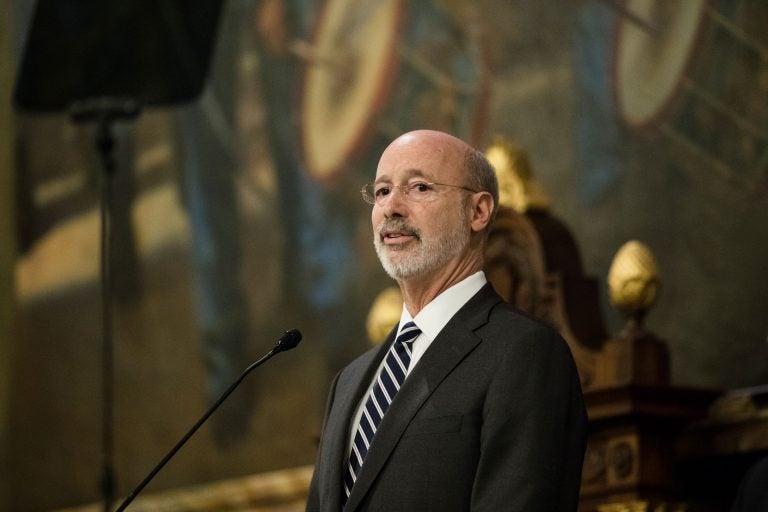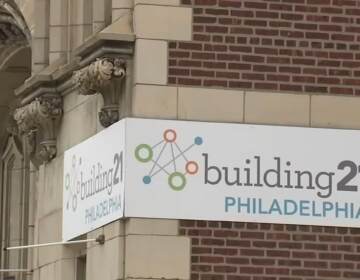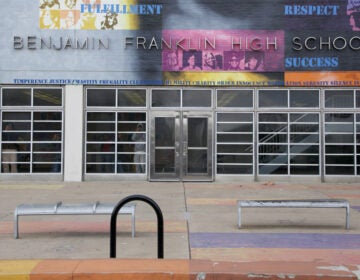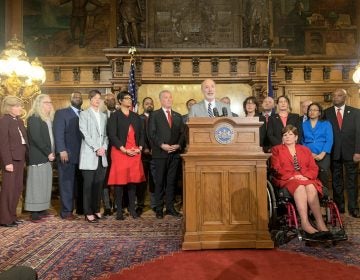Gov. Wolf to seek school construction aid amid health issues
Wolf's administration is developing a plan to help deal with aging school buildings plagued by environmental health problems, including lead paint and asbestos insulation.

Democratic Gov. Tom Wolf delivers his budget address for the 2019-20 fiscal year to a joint session of the Pennsylvania House and Senate in Harrisburg, Pa., Tuesday, Feb. 5, 2019. (Matt Rourke/AP Photo)
With budget season approaching, Gov. Tom Wolf’s administration is developing a plan to help deal with aging school buildings plagued by environmental problems, including lead paint and asbestos insulation, his office said.
Wolf must deliver a budget proposal to the Legislature on Feb. 4, and lawmakers who are pressing for state aid to address what they call a massive and growing problem have asked the Democratic governor to include money in the spending package.
Wolf has discussed the need in the past, saying that a sprawling infrastructure plan he floated last year could have been a source of help.
But that plan — a $4.5 billion infrastructure proposal to be paid off by imposing a tax on Marcellus Shale natural gas production — never saw a vote in the Republican-controlled Legislature, and Wolf’s office said he will try a new strategy to deal with deteriorating school buildings.
“Gov. Wolf remains committed to putting significant resources to protect kids from these harmful contaminants and will be proposing a new comprehensive plan in the near future,” Wolf’s office said in a statement.
In the Legislature, Rep. Elizabeth Fiedler and Sen. Vincent Hughes, both Philadelphia Democrats, have introduced legislation backed by labor unions, public school advocates and rank-and-file Democrats to marshal $125 million for the cause.
Wolf has sent about $12 million in aid to Philadelphia’s school district the past couple years, but his office said he recognizes that that is not nearly enough “and this crisis for our kids demands a statewide, substantial investment.”
The matter has been particularly visible recently in Philadelphia, where the district closed several schools last fall to clean up asbestos and has promised to step up its response to environmental health hazards.
The city’s teachers’ union sued over it Monday, several months after a longtime teacher contracted mesothelioma, a rare and aggressive cancer associated with inhalation of asbestos fibers.
Fiedler said she has heard from worried teachers who live in her district.
“And now these same folks are wondering whether they’re going to get the same diagnosis,” Fiedler said.
Schools practically everywhere in Pennsylvania are old. Most were built between 1950 and 1959, and more than 200 were built before 1950, said Sen. Vincent Hughes, D-Philadelphia. They have lead pipes, lead paint, asbestos insulation and mold, he said.
“Think about sending your child to a school that has that kind of contamination: lead or asbestos or mold, or it’s raining inside, not just outside, but inside from water leaking through the roof,” Hughes said.
Pennsylvania, beset by post-recession budget deficits, shut down a roughly $300 million-a-year school construction program five years ago, leaving even the poorest school districts since then to pay for improvement projects themselves.
Ending that construction money compounded longstanding and deep inequities in Pennsylvania’s distribution of state school aid that has underfunded districts that are poor and educate high proportions of children who are minorities, Hughes said.
“You can see the inequity and the underfunding easiest when you look at the infrastructure,” Hughes said.
Mark DiRocco, executive director of the Pennsylvania Association of School Administrators, said every geographic region of the state is struggling with old school buildings.
Two summers ago, a mold outbreak after a humid summer struck school buildings across the state, DiRocco said.
For decades, the state’s school construction aid had helped districts pay for major projects, with poor districts able to draw down a larger proportional reimbursement.
Since the state ended the aid, lawmakers rewrote the program’s guidelines to allow it to help with smaller projects, too, such as replacing a roof or a boiler, DiRocco said.
But, without money, it isn’t helping districts that don’t have the money to pay for the projects themselves, DiRocco said.
“Most districts are doing their best to keep them patched up, doing the small projects as they can afford them,” DiRocco said. “But as far as the big projects, many of them have been holding off in hopes that the state will come through down the road.”
WHYY is your source for fact-based, in-depth journalism and information. As a nonprofit organization, we rely on financial support from readers like you. Please give today.




